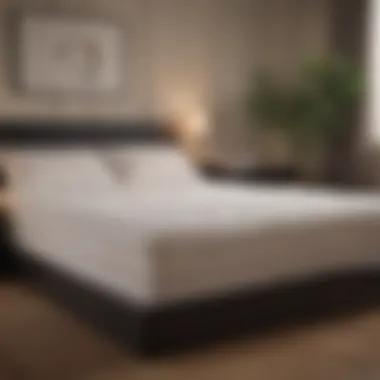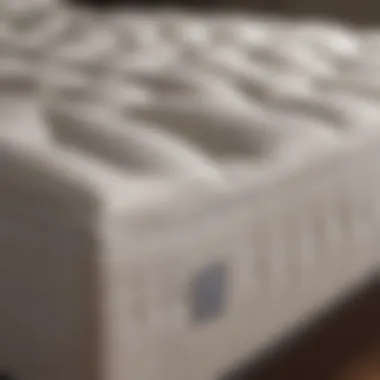The Best Bed Toppers: Enhancing Comfort and Sleep Quality


Intro
In the search for a better night’s sleep, many homeowners and sleep enthusiasts often overlook a vital element in their bedding setup: the bed topper. This simple addition can drastically change not only how comfortable your bed feels but also how well you sleep.
Bed toppers, often crafted from various materials, promise an enhancement of sleep quality by adding an extra layer of comfort. Different types of bed toppings cater to unique needs—some soften a firm mattress while others provide necessary support.
This article delves into the world of bed toppers, examining the types available, their advantages, and how to choose the best one suited for various preferences. Factors such as materials, thickness, firmness, and maintenance will be explored, leading to informed decision-making for those investing in their sleep quality.
Design Inspiration
Trending Styles
When selecting a bed topper, aesthetics also play a crucial role in enhancing bedroom decor. Many homeowners now look for toppers that not only provide comfort but also align with modern interior design trends. Popular styles include memory foam with sleek finishes or organic cotton for a more rustic and eco-friendly appeal.
Textures have become an influential element; tufted designs evoke a sense of elegance, while smooth, minimalist toppers reflect contemporary simplicity. It’s essential to consider how your choice complements the overall look of your bedroom, bringing together comfort and style seamlessly.
Color Palettes
Colors in bedding can influence the mood of a space. Neutral shades such as cream or grey are versatile and can match various themes. Meanwhile, soft pastels can create a tranquil atmosphere, fostering relaxation and calmness.
Dark colors may be chosen for a bold statement, especially in modern settings. It is wise to coordinate the color palette of your bed topper with existing bedding or wall colors, ensuring harmony throughout the room.
Practical Tips
Maintenance & Care
Maintaining a bed topper is crucial for long-term use and comfort. Regular cleaning is essential, as dust mites and allergens can accumulate over time. Many bed toppers come with removable covers, making it easier to wash and keep clean. For non-removable options, spot cleaning with mild detergents can suffice.
Budgeting & Planning
Investing in a good bed topper does not need to break the bank. Prices vary widely depending on material and brand, so it is critical to set a budget ahead. Look for sales, discounts, or even second-hand options that align with your requirements.
Choosing the right bed topper should involve careful planning and discernment. Personally testing the topper in-store can greatly enhance your selection process, ensuring comfort meets your expectations.
"A bed topper is not just an accessory; it is a commitment to better sleep and wellbeing."
Understanding Bed Toppers
Bed toppers are often overlooked in the quest for better sleep. They serve a unique purpose that goes beyond simply adding softness to your mattress. In this section, we will examine what bed toppers are, their objectives, and clarify popular misconceptions.
Definition and Purpose
A bed topper is a padding layer placed directly on top of a mattress to improve comfort and support. Its primary function is to enhance the sleeping experience by adjusting the feel of the mattress. Many individuals find their mattresses too firm or old, and a topper can adjust that without needing to buy a completely new bed. They come in various materials and thicknesses, affecting body contouring and pressure relief in different ways.
By using a bed topper, you can also prolong the life of your mattress. This protective layer helps guard against wear and tear, dirt, and moisture. As a result, it not only enhances comfort but also infuses longevity into your investment.
The versatility of bed toppers makes them suitable for many situations. Whether you have guests, are moving into a new home, or simply looking to enhance your sleep quality, bed toppers provide an easy and effective solution.
Common Misconceptions
Despite their benefits, several misconceptions about bed toppers persist.
- They are just for softness: Many people assume that bed toppers are solely designed to add softness to a mattress. However, they also provide support and alignment, which can mitigate issues like back pain.
- More thickness is better: It is a common belief that thicker toppers are always superior. While thickness is essential, it should align with personal comfort and sleeping position. A thicker topper may not be ideal for everyone.
- Toppers are only for old mattresses: New mattress owners often disregard toppers. They can also enhance even the best mattresses by adjusting firmness levels or temperature regulation.
- They are expensive: The market offers bed toppers at many price points, making high-quality options accessible to most budgets.
Types of Bed Toppers


Understanding the various types of bed toppers is essential for selecting the right one to enhance comfort and sleep quality. Each type serves distinct functions, catering to specific sleep needs, preferences, and physical conditions. In this section, we will explore the characteristics, benefits, and considerations associated with five common types of bed toppers.
Memory Foam Bed Toppers
Memory foam bed toppers are popular for their ability to contour to the body. This material responds to heat and pressure, creating a personalized sleeping surface that alleviates pressure points. As the foam compresses around you, it helps in alignment of the spine, making it beneficial for those with chronic pain or joint issues.
One of the main advantages of memory foam is its ability to absorb motion. This makes it an excellent choice for couples, as movement on one side of the bed won't disturb the other person. However, it can retain heat, which may not be suitable for those who sleep hot. Also, consider the density of the foam. Higher density offers better support and durability, while lower density provides a softer feel but may wear out quicker.
Latex Bed Toppers
Latex bed toppers are known for their durability and resilience. Made from natural or synthetic latex, they offer a firmer feel compared to memory foam. This type provides excellent support and can help maintain proper spinal alignment. Natural latex is often preferred due to its hypoallergenic properties, making it safe for those with allergies.
Another significant benefit of latex toppers is their breathability. They generally sleep cooler than memory foam, making them suitable for people who tend to overheat at night. However, potential buyers should note that latex toppers can be heavier and may come at a higher price point compared to other options.
Feather and Down Bed Toppers
Feather and down bed toppers bring a plush and luxurious feel to the mattress. Down is the soft undercoating found on ducks and geese, while feathers are the outer covering. This blend creates a soft, fluffy surface that enhances comfort, particularly for those who prefer a softer sleep environment.
However, it should be noted that this type of topper may not provide as much support or pressure relief compared to memory foam or latex. Additionally, some individuals may have allergies related to feathers and down. It’s crucial to check the fill power and quality; higher fill power offers better insulation and comfort. Regular fluffing and cleaning can also maintain the topper’s longevity.
Polyester and Fiber Bed Toppers
Polyester and fiber bed toppers are budget-friendly alternatives that can still enhance the quality of sleep. These toppers are typically lightweight and easy to maintain. They provide a softer layer of comfort and can help to protect your mattress.
While these toppers are affordable, they might not last as long or offer the same level of support compared to other materials like latex or memory foam. Thus, they might be more suitable for temporary use or for those seeking a less expensive option. Be aware that they may flatten over time, requiring replacement sooner than other types.
Gel-infused Bed Toppers
Gel-infused bed toppers are designed to combine the best attributes of foam with the cooling properties of gel. This innovative design aims to address the heat retention issue commonly faced by traditional memory foam. The gel infusion allows for better air circulation, resulting in a cooler sleep environment.
These toppers maintain the body-contouring abilities of memory foam, providing pressure relief without the excessive heat buildup. When choosing a gel-infused topper, look for quality materials that ensure durability and effectiveness. They come in varying thicknesses and densities, so it is crucial to select one that aligns with your comfort needs.
Each type of bed topper offers unique advantages and caters to different sleeping preferences. Understanding these distinctions is crucial for an informed decision on enhancing sleep quality.
Benefits of Using Bed Toppers
Understanding the benefits of bed toppers is essential for anyone considering an upgrade to their sleep experience. These products can significantly enhance comfort and extend the life of an existing mattress. By exploring several specific elements, we can appreciate their practical advantages.
Enhanced Comfort
One of the foremost reasons to consider a bed topper is the immediate improvement in comfort. Bed toppers introduce an extra layer of softness or support, which can make a significant difference in how we feel during sleep. For instance, a memory foam topper conforms to the body, easing pressure points. This can be particularly beneficial for those with chronic pain or discomfort. As a result, added comfort leads to better overall contentment with one's sleeping situation.
Improved Sleep Quality
Quality of sleep is crucial for overall health. A bed topper can contribute to enhanced sleep quality. When the sleeping surface aligns better with the body’s shape, disruptions are minimized. For people who experience tossing and turning, this can result in longer, uninterrupted sleep cycles. Regular use of a high-quality bed topper can transform a restless night into a restorative experience, ultimately supporting better mental and physical health.
Prolonging Mattress Lifespan
Investing in a bed topper can also serve as a protective measure for your mattress. It acts as a barrier, reducing wear and tear. By absorbing impacts and the stresses associated with nightly use, toppers can help extend the life of a mattress beyond its typical lifespan. Over time, this can translate into financial savings, as you will not need to replace mattresses as frequently. Choosing the right topper can be a strategic move in home maintenance.
Support for Different Sleep Positions
Another key advantage of bed toppers is their ability to accommodate various sleep positions. Whether someone sleeps on their side, back, or stomach, the right topper can provide the necessary support. For example, a firmer topper may be preferred by back sleepers, while side sleepers may benefit from a softer, more conforming material. This adaptability helps meet individual needs and ensures that everyone can find a suitable solution to enhance their sleep experience.
Factors to Consider When Choosing a Bed Topper


Choosing the right bed topper is crucial for enhancing comfort and improving sleep quality. Several factors determine how well a topper will meet individual needs. Understanding these elements can significantly affect the comfort level and overall satisfaction with sleep. Considering things like material type, thickness, firmness, allergies, and budget will help guide consumers in selecting the right product.
Material Types
The material of the bed topper is often the most important factor to consider. Different materials offer varying levels of comfort, support, and durability. Common materials include memory foam, latex, feather, and polyester.
- Memory Foam conforms to the body shape, providing excellent pressure relief and support. However, it can trap heat, which not everyone prefers.
- Latex toppers offer a more responsive and bouncier feel while maintaining support. They are also more breathable than memory foam, which helps with heat regulation.
- Feather and Down toppers provide a plush feel. They are soft and cozy but may not offer as much support as other materials.
- Polyester and Fiber toppers are often budget-friendly. Though they may lack the durability of other types, they provide a reasonable level of comfort.
Each material serves different preferences, making it vital to consider personal sleeping habits when choosing.
Thickness and Firmness
Thickness and firmness are significant aspects to consider too. Thicker toppers often provide more cushioning, while thinner ones may offer minimal support enhancements. A common range is 1 to 4 inches in thickness. Here’s a breakdown:
- Thin Toppers (1-2 inches) are suitable for those who want a little added comfort without overwhelming the original mattress feel.
- Medium Toppers (2-3 inches) provide a balance of support and softness, making them versatile for different sleeping preferences.
- Thick Toppers (3-4 inches) cushion the body well, ideal for individuals with specific needs like joint pain or back issues.
Firmness scales vary from soft to firm. Choosing the appropriate firmness that matches personal preference and sleep position is essential. Back sleepers generally favor firmer options, while side sleepers may do better with softer ones.
Allergies and Sensitivities
For individuals prone to allergies, the choice of materials becomes crucial. Some materials, such as certain types of memory foam, can off-gas chemical odors that may trigger sensitivities. Options like latex may not be suitable for those with latex allergies.
Choosing hypoallergenic materials can reduce the impact of allergens while sleeping. It's important to look for bed toppers treated to resist dust mites, mold, and mildew. Regularly checking for odors and ensuring good ventilation helps maintain a healthy sleep environment.
Budget Considerations
Financial constraints should be taken into account when selecting a bed topper. Prices can vary significantly based on materials and brands. While investing in a high-quality product may offer better durability and comfort, there are also budget-friendly options that perform decently.
Evaluating how often a bed topper will be used and how much comfort is desired can help align choices with budget. Purchasing from reputable brands can sometimes may offer good warranty options, highlighting a commitment to quality.
Sizing and Fit
Choosing the right size and fit for a bed topper is critical for both comfort and functionality. A well-fitted topper can enhance a mattress's capabilities, providing additional support while ensuring sleep stability. If the topper does not align properly with the dimensions of your mattress, it may lead to discomfort, movement issues, and even affect sleep quality. It is not just about comfort; size considerations also involve practical aspects such as ease of placement and maintenance, which will be discussed further.
Standard Bed Sizes
Standard bed sizes include twin, full, queen, king, and California king. Knowing these dimensions is essential before purchasing a bed topper.
- Twin: 39 x 75 inches
- Full: 54 x 75 inches
- Queen: 60 x 80 inches
- King: 76 x 80 inches
- California King: 72 x 84 inches
These sizes represent the typical dimensions of mattresses found in homes today. When selecting a bed topper, ensure it matches the respective bed size. A mismatched size may result in the topper sliding around, which could diminish comfort during sleep.
A bed topper that fits neatly within the mattress's boundaries will help maintain the topper's shape and efficiency. It also allows for better alignment with bed linens and blankets, promoting a more integrated sleep environment.
Custom Bed Configurations
Some individuals may have custom bed sizes or unique configurations. This is especially common in adjustable beds, or for those with substitute designs that do not adhere strictly to standard dimensions. For custom beds, accurate measurements are essential.
For a proper fit:
- Measure width and length of the bed surface.
- Consider any specific features, such as indents for adjustable bases.
- Think of material thickness, as some toppers may require additional space for comfort.
Investing in a tailored topper allows homeowners to fully utilize their unique bed setup. It also helps in achieving optimal comfort levels based on personal sleeping preferences. If the topper is too big or too small, it may lead to dissatisfaction with sleep quality.
"A well-fitted topper not only enhances comfort but also protects the underlying mattress from wear and tear."


Care and Maintenance
Care and maintenance of bed toppers is essential for maximizing their lifespan and maintaining their performance. A well-maintained bed topper not only enhances your sleep quality but also ensures that you are protected from allergens and dust mites. Regular care helps preserve the material properties of the topper, ensuring consistent comfort.
Cleaning Guidelines
Cleaning your bed topper is vital. It prevents the buildup of dirt, allergens, and odors. Here are some important steps you can follow to clean your bed topper effectively:
- Check the Care Label: Always begin by reviewing the manufacturer's care instructions. Different materials require varied approaches for cleaning.
- Spot Clean: For small stains, use a damp cloth with mild soap. Avoid soaking the topper as this can damage the materials.
- Machine Wash: If the bed topper is machine-washable, utilize a gentle cycle with cold water. Use a mild detergent to avoid damaging the fibers.
- Dry Thoroughly: After washing, ensure the topper is dried completely. This avoids the growth of mold and maintains hygiene.
- Deodorize: Periodically sprinkle baking soda on the topper, allow it to sit for an hour, then vacuum it off to remove odors.
Storage Recommendations
When it comes to storing your bed topper, proper techniques are important to prevent damage. Here are some tips for effective storage:
- Clean Before Storing: Ensure your topper is completely clean and dry before storing. This prevents stains and mildew from forming.
- Roll, Don’t Fold: Store the topper by rolling it instead of folding it. This avoids creasing that can affect the comfort and shape over time.
- Use a Protective Cover: Place the topper in a breathable storage bag or cover. This protects it from dust and other contaminants while allowing airflow.
- Store in a Cool, Dry Place: Choose a storage location that is cool and dry, away from direct sunlight. Heat and humidity can deteriorate the material.
"A little maintenance goes a long way in preserving the comfort and longevity of your bed topper."
In summary, the care and maintenance of bed toppers require deliberate actions. Regular cleaning and proper storage significantly influence durability and performance.
Potential Drawbacks of Bed Toppers
Bed toppers have become increasingly popular among individuals seeking enhanced comfort during sleep. However, it is crucial to examine their potential drawbacks. Understanding these issues can aid homeowners and design enthusiasts in making educated choices.
Heat Retention Issues
One common drawback is heat retention. Many bed toppers, especially those made from memory foam, are known to trap body heat. This can lead to excessive warmth during the night, causing discomfort for some users. Those who often sleep hot may find themselves waking frequently due to heat.
To mitigate this issue, look for cooling gel-infused memory foam toppers or toppers made from breathable materials like latex or wool. These alternatives allow for better airflow, aiding in temperature regulation during sleep.
Motion Transfer
Motion transfer is another consideration when using bed toppers. This is a measurement of how much movement on one side of the bed affects the other side. If your partner shifts or gets out of bed, the motion can disturb your sleep if the bed topper is too soft or pliable.
Latex bed toppers generally perform better in this regard as they offer a balance between comfort and support. Couples should pay attention to this factor if they share a bed to ensure restful nights.
Possible Odors
New bed toppers sometimes emit odors, particularly if they are made from synthetic materials. This phenomenon, often referred to as off-gassing, can be bothersome, especially in a sleep environment. The smell can be strong during the first few days after unpacking.
To address this, consider airing out the topper in a well-ventilated area before using it. Opting for eco-friendly materials can also reduce the chances of unpleasant odors.
Choosing a bed topper requires understanding both its advantages and drawbacks to ensure you select the best option for your sleep needs.
In summary, while bed toppers offer numerous benefits like improved sleep quality and comfort, it is essential to remain aware of their potential issues. Evaluating heat retention, motion transfer, and possible odors can guide customers in selecting the right product suited to their personal preferences.
Culmination
This article underscores the significant role that bed toppers play in enhancing comfort and sleep quality. Understanding the different types of bed toppers, such as memory foam, latex, and gel-infused options, helps individuals make informed choices. Each type offers unique benefits, impacting not only comfort but also the overall sleep experience.
Key considerations, including material choice, thickness, and potential allergens, are essential in the selection process. By addressing common misconceptions and potential drawbacks like heat retention and motion transfer, homeowners and sleep enthusiasts can navigate their options effectively. Quality sleep is vital for overall well-being, and investing in a suitable bed topper can be a crucial step in achieving this goal.
Recap of Key Points
- Types of Bed Toppers: Various materials such as memory foam, latex, and down provide distinct feels and support levels.
- Benefits: Bed toppers enhance comfort, improve sleep quality, and can extend mattress lifespan.
- Selection Factors: Evaluating thickness, firmness, and sensitivities ensure the right choice for individual needs.
- Maintenance: Proper care can prolong the life of a bed topper.
Final Recommendations
When choosing a bed topper, align your selection with personal sleep preferences and any specific needs. Test out different types, if possible, to discover what feels most supportive and comfortable. Always budget for a topper that not only fits your mattress size but also your overall sleeping habits. Invest in a quality product from reputable brands to maximize benefits.
For more information on maintaining and selecting bed toppers, you can explore resources like Wikipedia or Britannica. Don't forget to check forums such as Reddit for real user experiences.















